Porcelain Crowns-Bridges
Maximum Esthetics
Nowadays we have a wide range of possibilities to utilize when it comes to restore a tooth with a esthetic looking crown.In dentistry we talk about two type of porcelain restorations namely pfm crowns (porcelain fused to metal) and full porcelain crowns.
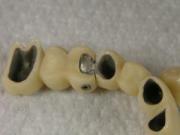 Porcelain-Fused-to-Metal Crowns
Porcelain-Fused-to-Metal Crowns
Porcelain-fused-to-metal crowns provide for a strong, durable, and esthetic treatment option. One of the key factors for the esthetic and functional success of this type of crown is ensuring the preparation of the underlying tooth structure provides adequate space for the appropriate thickness of the material selected. Additionally, the artistic skill of the laboratory technologist creating the crown will determine its esthetic appeal.
One consideration in the porcelain-fused-to-metal crown is that these crowns may tend to show the underlying metal or gold margin at the gum line as gums recede over time. Some patients opt for this type of crown, but replace the crown at a later date in order to maintain a higher esthetic benefit. Porcelain-fused-to-metal crowns with an all porcelain collar can eliminate this vulnerability.
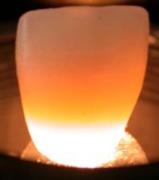 PFM Crowns have such problems
PFM Crowns have such problems
- After gingival recessions dark lines are witnessed
- At spot lights or flash lights you see a shadow effect from the metal underneath the porcelain.
- Some people may have allergic reactions against the metals that are used
- They are only mecanically cemented to teeth.
These reasons make us elect as a material of choice the full porcelain crowns especially in the esthetic zone
Full Porcelain Crowns
The predominant material choice for all-ceramic crowns today is either zirconia, or aluminous materials. They provide a metal-free esthetic option with a number of benefits.
By eliminating the need for the supportive metal core, an esthetic all-ceramic crown can be created with a reduced thickness of material. This makes them a more favorable treatment choice in areas with limited space. Additionally, the elimination of the metal core allows for light transmission through the porcelain for better optical, life-like properties and a higher level of esthetics.
All-ceramic materials continue to evolve in strength and durability, but caution should still be exercised for areas of the mouth requiring heavy function. Continuing research is exploring the significant vulnerabilities of the porcelain systems in such areas
Full Porcelain Crowns
- Even at gum recessions you do not get any dark lines visible at the crown margins
- Light translucency is close to normal tooth structure.
- They can be both cemented and bonded to the tooth so they are more retentive
Our todays most up to date porcelain materials we use at crown and bridge restorations are.
Glass Ceramics
These are pressed at special mashines.They have a ery good light transmission values and therefore prefered in the anterir region(front teeth. They are not so strong and resistant to be used in the posterior region,especially with bridges.
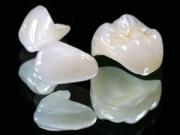
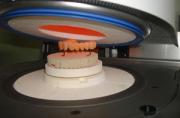
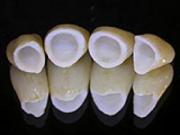
Zirconium
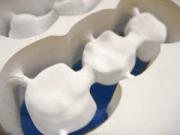 Zirconium oxite has been widely used in medicine as hip or joint implant materials.And ever since the production cost of this oxite dropped dramatically it also found field of use in dentistry as a crown and bridge material which with its strenght is to substitute the metal framework.As an esthetic and reliably strong material zirkonium oxides are offering a good alternative to replace the posterior pfm bridges(porcelain fused to metal )This material is not only heat and shock resistant but at the same time it doesnt transmitt heat end elecricity so the sensitivity that you find due to electrolisis at metallic crown and bridges with other metallic elements such as amalagam fillings or clasps of partial dentures you dont have with zirconium oxites.I tis a light material and has a good tansmission of light.With these crown and bridges,
Zirconium oxite has been widely used in medicine as hip or joint implant materials.And ever since the production cost of this oxite dropped dramatically it also found field of use in dentistry as a crown and bridge material which with its strenght is to substitute the metal framework.As an esthetic and reliably strong material zirkonium oxides are offering a good alternative to replace the posterior pfm bridges(porcelain fused to metal )This material is not only heat and shock resistant but at the same time it doesnt transmitt heat end elecricity so the sensitivity that you find due to electrolisis at metallic crown and bridges with other metallic elements such as amalagam fillings or clasps of partial dentures you dont have with zirconium oxites.I tis a light material and has a good tansmission of light.With these crown and bridges,
- you do not have cold and hot sensitivity
- you have a material which is not opaque
- you have a non allergic material
- you have a very compatible material with gingiva
- you have a material with less plaque accumulation index meaning that you are going to have a better oral hygiene, that makes it the material of choise not only in the posterior (back molars) but also in the anterior region(front teeth area) ass well
